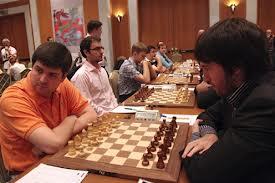
Initiative in Endgames, Part 6
This article and the next article will wrap up the series on Initiative in Endgames. Here, I offer you a series of endgame positions from the recent 28th European Club Cup.
The first two positions are unique, and the themes include zugzwang and pinned pieces while being up on material. While the first position is tactical the second one is more on the positional side. In the first position white is better due to their active pieces and the poor placement of the black king. This is a critical position and Volokitin has two choices: take the knight on f7 or take the bishop on g6. Each move requires calculations and precise evaluation of the resulting position. One move leads to a draw while the other one to a disaster--this is the thin line that Volokitin had to walk next to the ticking clock.
In the second position Rodshtein is up a pawn and is playing for a win. Maybe playing for a win while the Bd4 rules over the board is not the most prudent decision but this was a team tournament and perhaps due to the team situation Rodshtein had to play for a win. Rook and bishop is generally better than rook and knight, especially if the knight is pinned. Giri finds a brilliant idea, which is not obvious at first but once you see it hopefully you will be as impressed as I was.
In the next position black is up a pawn but cannot be better because white has a strong passed d6-pawn. Therefore, black should recognize that the initiative is on white's side and pull his forces back to regroup for defense. Navara will win two pawns but the endgame promises to transpose into opposite-colored bishops endgame, which given the limited material is most-likely a draw.
Nakamura is in trouble due to the mating net around his king. With his last move he attacks the e4-pawn with the bishop. Black has a powerful initiative and wants to play Rxa2 but it wouldn't work because Bxe4 is with check - threatening Bxf3. Therefore, Popilski has two choices: to take the bishop on d5 right away or to defend the e4-pawn. One continuation leads to a win, while the other to only a slight advantage.
In the next position white is clearly better due to the strong passed d-pawn, active pieces and the weak black king. To quench white's initiative Palac must trade queens. It would take no effort to hold the rook endgame because the king could participate in the defense, which cannot happen when the queens are present at the board. In the game Palac chose an active defense, which turned out to be a disaster because white's attack progressed rapidly.
We looked at several interesting endgames from the recent Euro Team Cup and will finish with the remaining examples next week.






